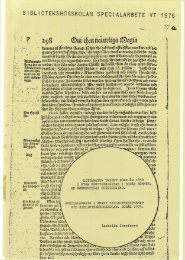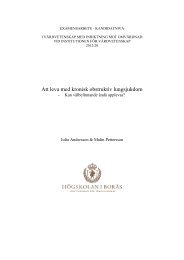Katalogisering och klassificering av sagor och folklore - BADA
Katalogisering och klassificering av sagor och folklore - BADA
Katalogisering och klassificering av sagor och folklore - BADA
Create successful ePaper yourself
Turn your PDF publications into a flip-book with our unique Google optimized e-Paper software.
Pettee tar också upp flera tänkbara syften med katalogiseringen <strong>av</strong> litteratur. I <strong>och</strong> med<br />
att varje katalog gjordes speciellt för den boksamling den skulle gälla för kom det att<br />
utformas många olika metoder för katalogisering, var <strong>och</strong> en ultimat för sitt eget syfte,<br />
men ingen som var universellt tillämplig.<br />
Each catalog was compiled for its own collection. [- - -] In the history of European<br />
libraries catalogs of books h<strong>av</strong>e served various needs. In studying the purposes for<br />
which they were made we can sift the different factors in the entries and can note the<br />
growing differentiation of author, subject, and title elements.<br />
The first purpose served by the catalog was purely that of an inventory list. Books<br />
were valuable property to be accounted for to anoverlord together with other<br />
possessions. [- - -]<br />
Later, in the medieval monastic lists, we occasionally find some attempt at a<br />
systematic arrangement by authors. Here we see a new purpose emerging. The list is<br />
coming to be used not only as a register of property but as a finding list arranged for<br />
ready access to the books. 54<br />
Hon talar om tre stadier inom utvecklingen <strong>av</strong> katalogiseringsmetoder:<br />
In the evolution of catalogs we can clearly distinguish three stages corresponding to<br />
the purposes for which they were made. The first purpose was to account for<br />
property. The catalog is an inventory list. This function has now been completely<br />
taken over by a supplementary list, the shelf-list. In the second stage purpose is to<br />
provide a finding-list for particular books. [- - -] A third purpose, that of assembling<br />
literary units, has come to the front as important, and our term ”main entry”<br />
recognizes this as a primary function. In this third stage our catalogs are highly<br />
developed instruments. Author, subject, and title entry are now clearly differentiated.<br />
Authorship determines the main entry. We h<strong>av</strong>e relegated the finding-list function to<br />
”secondary entries,” where the main entry is inadequate for quickly ”finding” the<br />
individual book. 55<br />
Angående problemet som vi tittar på i denna uppsats, katalogisering <strong>av</strong> dokument utan<br />
enskilda definierade upphovsmän, skriver hon vidare:<br />
Books, in the Western world, are primarily associated with the man responsible for<br />
their creation. This is sound psychology from which there has been no important<br />
deviation. Where the author is an individual and the authorship is known, the<br />
personal entry under author, from the very beginning of European cataloging<br />
practise, has taken precedence over title or any other entry form. The form of entry<br />
for works without personal authors in evidence is still a matter upon which there is<br />
no general agreement in practise. [- - -]<br />
Thus bibliographical lists from the beginning h<strong>av</strong>e dealt with two classes of<br />
literature – books whose authorship is known; and the anonymi, all books where no<br />
personal author is in evidence. The entries for the anonymi, like the entries for the<br />
manuscripts with known authors, are succinct and easily remembered phrases<br />
descriptive of the contents of the manuscripts themselves. 56<br />
Pettee ger några typiska exempel på anonyma författares böcker med dylika deskriptiva<br />
titlar, däribland Questiones in Genesi, Regulae quatuor <strong>och</strong> Tripartita historia, för att<br />
nämna några tydliga <strong>och</strong> klargörande exempel. Dessa <strong>och</strong> ett större flertal andra<br />
katalogiserades emellertid under 1000-talet, när katalogiseringsprinciperna inte kommit<br />
till riktigt fullkomligt, varför de nämns i allra sist i katalogen under samlingsuppslaget<br />
54 Pettee, s. 76<br />
55 Pettee, s. 84-85<br />
56 Pettee, s. 77<br />
33

















